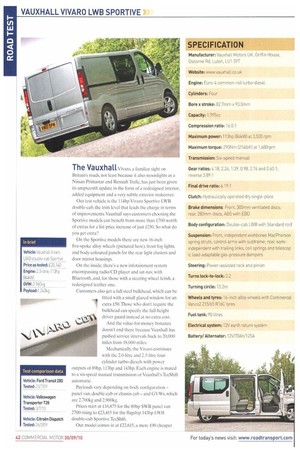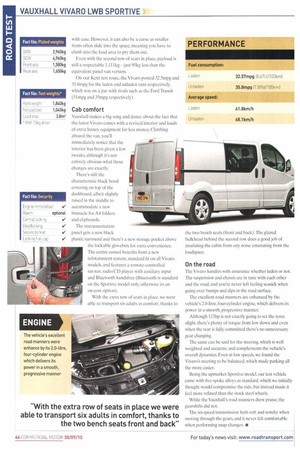The Vauxhall Vivaro, a familiar sight on Britain's roads, not
Page 42

Page 43

Page 44

If you've noticed an error in this article please click here to report it so we can fix it.
least because it also moonlights as a Nissan Prirnastar and Renault Trafic, has just been given its umpteenth update in the form of a redesigned interior, added equipment and a very subtle exterior makeover.
Our test vehicle is the 114hp Vivaro Sportive LWB double-cab, the trim level that leads the charge in terms of improvements. Vauxhall says customers choosing the Sportive models can benefit from more than £700 worth of extras for a list price increase of just £250. So what do you get extra?
On the Sportive models there are new 16-inch five-spoke alloy wheels (pictured here), front fog lights. and body-coloured panels for the rear light clusters and door mirror housings.
On the inside, there's a new infotainment system encompassing radio/CD player and sat-nay, with Bluetooth, and, for those with a steering wheel fetish, a redesigned leather one.
Customers also get a full steel bulkhead, which can be fitted with a small glazed window for an extra £50. Those who don't require the bulkhead can specify the full-height driver guard instead at no extra cost.
And the value-for-money bonanza doesn't end there because Vauxhall has pushed service intervals back to 20,000 miles from 18,000 miles.
Mechanically, the Vivaro continues with the 2.0-litre and 2.5-litre fourcylinder turbo-diesels with power outputs of 89hp. 113hp and 143hp. Each engine is mated to a six-speed manual transmission or Vauxhall's TecShift automatic.
Payloads vary depending on body configuration — panel van, double-cab or chassis cab — and GVWs, which are 2.700kg and 2,900kg.
Prices start at £16,875 for the 89hp SWB panel van 2700 rising to £23,415 for the flagship 143hp LWB double-cab Sportive TeeShift.
Our model comes in at £22,615, a mere £90 cheaper than the equivalent Transit 300 double-cab-in-van.
Productivity A double-cab van's productivity should be measured in relative terms, considering the second row of seats occupies half the loadspace of an equivalent panel van variant.
So, as a people-carrying load-lugger, our Vivaro was extremely capable, and there's ample room for three in the back in addition to the twin passenger seat up front,
Moving towards the rear, the Vivaro boasts 4.2m3 load volume, thanks in part to the 3.5.-metrelong wheelbase,
To compensate for the smaller load volume. Vauxhall has designed a clever storage area underneath the second row of seats, which is accessible only from the load area. This little cove allows operators to transport longer items
1111■Nourraiiiii0=110.111010110111r
with ease. However, it can also be a curse as smaller items often slide into the space, meaning you have to climb into the load area to pry them out.
Even with the second row of seats in place, payload is still a respectable 1.111 kg — just 95kg less than the equivalent panel van version.
On our Kent test route, the Vivaro posted 32.5mpg and 35.8mpg for the laden and unladen runs respectively, which was on a par with rivals such as the Ford Transit (31mpg and 35mpg respectively).
Cab comfort Vauxhall makes a big song and dance about the fact that the latest Vivaro comes with a revised interior and loads of extra luxury equipment for less money. Climbing aboard the van, you'll immediately notice that the interior has been given a few tweaks, although it's not entirely obvious what those changes are exactly.
There's still the characteristic black hood covering on top of the dashboard, albeit slightly raised in the middle to accommodate a new binnacle for A4 folders and clipboards.
The instrumentation panel gets a new black plastic surround and there's a new storage pocket above the lockable glovebox for extra convenience. The centre consol benefits from a new infotainment system. standard fit on all Vivaro models, and features a remote-controlled sat-nav, radio/CD player with auxiliary input and Bluetooth handsfree (Bluetooth is standard on the Sportive model only, otherwise its an on-cost option).
With the extra row of seats in place, we were able to transport six adults in comfort, thanks to the two bench seats (front and back).The glazed bulkhead behind the second row does a good job of insulating the cabin from any noise emanating from the loadspace.
On the road The Vivaro handles with assurance whether laden or not. The suspension and chassis are in tune with each other and the road, and you're never left feeling seasick when going over bumps and dips in the road surface.
The excellent road manners are enhanced by the vehicle's 2.0-litre, four-cylinder engine, which delivers its power in a smooth, progressive manner.
Although 113hp is not exactly going to set the tyres alight, there's plenty of torque from low down and even when the rear is fully committed there's no unnecessary gear changing.
The same can be said for the steering, which is well weighted and accurate, and complements the vehicle's overall dynamics. Even at low speeds, we found the Vivaro's steering to be balanced, which made parking all the more easier.
Being the upmarket Sportive model, our test vehicle came with five-spoke alloys as standard, which we initially thought would compromise the ride, but instead made it feel more refined than the stock steel wheels While the Vauxhall's road manners drew praise, the gearshifts did not.
The six-speed transmission feels soft and notchy when moving through the gears, and it never felt comfortable when performing snap changes.




























































































































